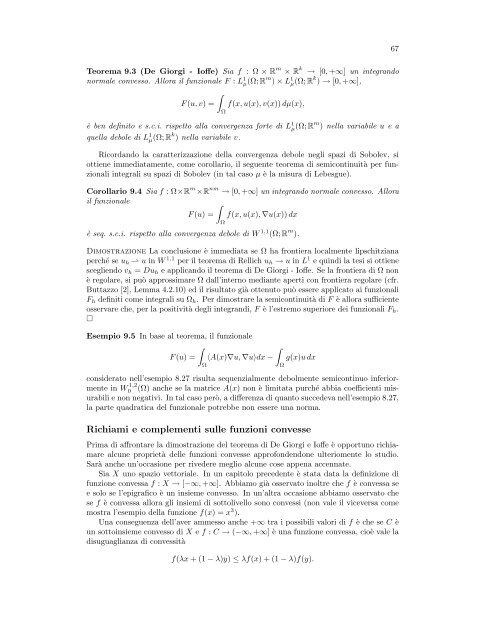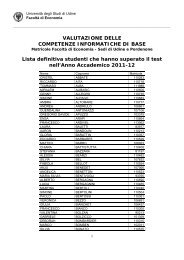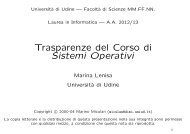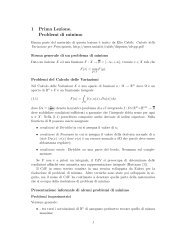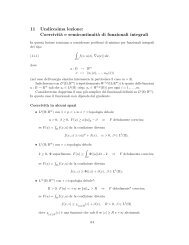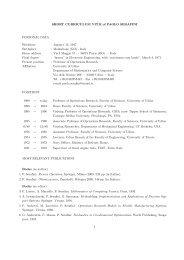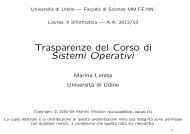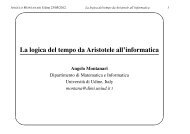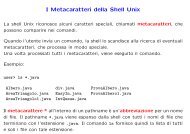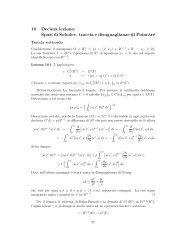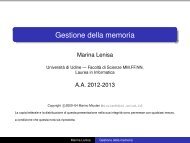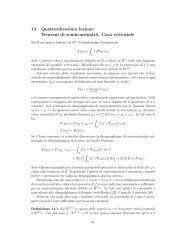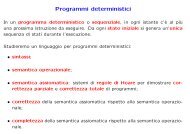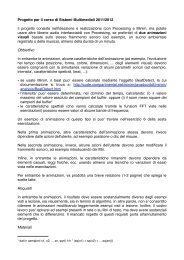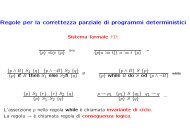Capitolo 9 - Dipartimento di Matematica e Informatica
Capitolo 9 - Dipartimento di Matematica e Informatica
Capitolo 9 - Dipartimento di Matematica e Informatica
Create successful ePaper yourself
Turn your PDF publications into a flip-book with our unique Google optimized e-Paper software.
Teorema 9.3 (De Giorgi - Ioffe) Sia f : Ω × R m × R k → [0, +∞] un integrando<br />
normale convesso. Allora il funzionale F : L1 µ(Ω; R m ) × L1 µ(Ω; R k ) → [0, +∞],<br />
<br />
F (u, v) = f(x, u(x), v(x)) dµ(x),<br />
Ω<br />
è ben definito e s.c.i. rispetto alla convergenza forte <strong>di</strong> L 1 µ(Ω; R m ) nella variabile u e a<br />
quella debole <strong>di</strong> L 1 µ(Ω; R k ) nella variabile v.<br />
Ricordando la caratterizzazione della convergenza debole negli spazi <strong>di</strong> Sobolev, si<br />
ottiene imme<strong>di</strong>atamente, come corollario, il seguente teorema <strong>di</strong> semicontinuità per funzionali<br />
integrali su spazi <strong>di</strong> Sobolev (in tal caso µ è la misura <strong>di</strong> Lebesgue).<br />
Corollario 9.4 Sia f : Ω×R m ×R nm → [0, +∞] un integrando normale convesso. Allora<br />
il funzionale<br />
<br />
F (u) = f(x, u(x), ∇u(x)) dx<br />
è seq. s.c.i. rispetto alla convergenza debole <strong>di</strong> W 1,1 (Ω; R m ).<br />
Ω<br />
Dimostrazione La conclusione è imme<strong>di</strong>ata se Ω ha frontiera localmente lipschitziana<br />
perché se uh ⇀ u in W 1,1 per il teorema <strong>di</strong> Rellich uh → u in L 1 e quin<strong>di</strong> la tesi si ottiene<br />
scegliendo vh = Duh e applicando il teorema <strong>di</strong> De Giorgi - Ioffe. Se la frontiera <strong>di</strong> Ω non<br />
è regolare, si può approssimare Ω dall’interno me<strong>di</strong>ante aperti con frontiera regolare (cfr.<br />
Buttazzo [2], Lemma 4.2.10) ed il risultato già ottenuto può essere applicato ai funzionali<br />
Fh definiti come integrali su Ωh. Per <strong>di</strong>mostrare la semicontinuità <strong>di</strong> F è allora sufficiente<br />
osservare che, per la positività degli integran<strong>di</strong>, F è l’estremo superiore dei funzionali Fh.<br />
<br />
Esempio 9.5 In base al teorema, il funzionale<br />
<br />
<br />
F (u) = 〈A(x)∇u, ∇u〉dx −<br />
Ω<br />
Ω<br />
g(x)u dx<br />
considerato nell’esempio 8.27 risulta sequenzialmente debolmente semicontinuo inferiormente<br />
in W 1,2<br />
0 (Ω) anche se la matrice A(x) non è limitata purché abbia coefficienti misurabili<br />
e non negativi. In tal caso però, a <strong>di</strong>fferenza <strong>di</strong> quanto succedeva nell’esempio 8.27,<br />
la parte quadratica del funzionale potrebbe non essere una norma.<br />
Richiami e complementi sulle funzioni convesse<br />
Prima <strong>di</strong> affrontare la <strong>di</strong>mostrazione del teorema <strong>di</strong> De Giorgi e Ioffe è opportuno richiamare<br />
alcune proprietà delle funzioni convesse approfondendone ulteriomente lo stu<strong>di</strong>o.<br />
Sarà anche un’occasione per rivedere meglio alcune cose appena accennate.<br />
Sia X uno spazio vettoriale. In un capitolo precedente è stata data la definizione <strong>di</strong><br />
funzione convessa f : X → [−∞, +∞]. Abbiamo già osservato inoltre che f è convessa se<br />
e solo se l’epigrafico è un insieme convesso. In un’altra occasione abbiamo osservato che<br />
se f è convessa allora gli insiemi <strong>di</strong> sottolivello sono convessi (non vale il viceversa come<br />
mostra l’esempio della funzione f(x) = x 3 ).<br />
Una conseguenza dell’aver ammesso anche +∞ tra i possibili valori <strong>di</strong> f è che se C è<br />
un sottoinsieme convesso <strong>di</strong> X e f : C → (−∞, +∞] è una funzione convessa, cioè vale la<br />
<strong>di</strong>suguaglianza <strong>di</strong> convessità<br />
f(λx + (1 − λ)y) ≤ λf(x) + (1 − λ)f(y).<br />
67


